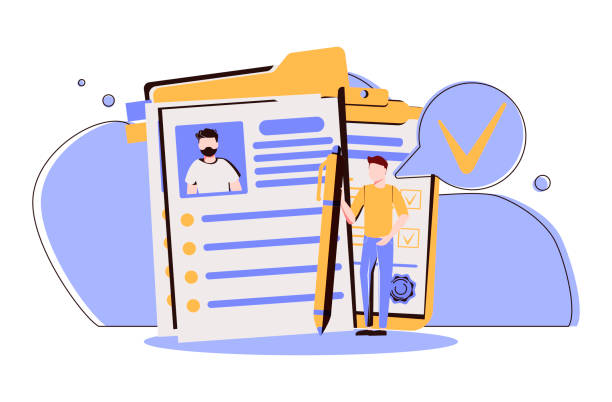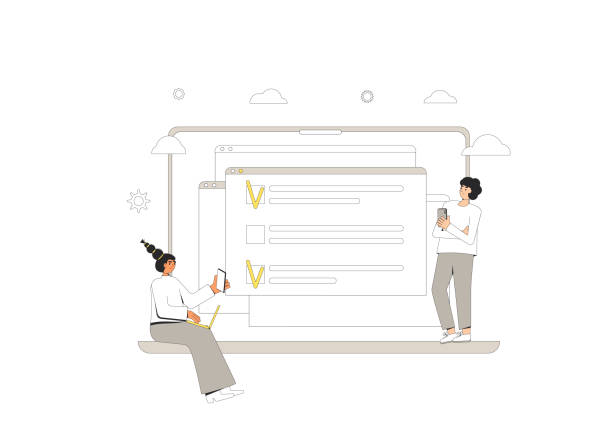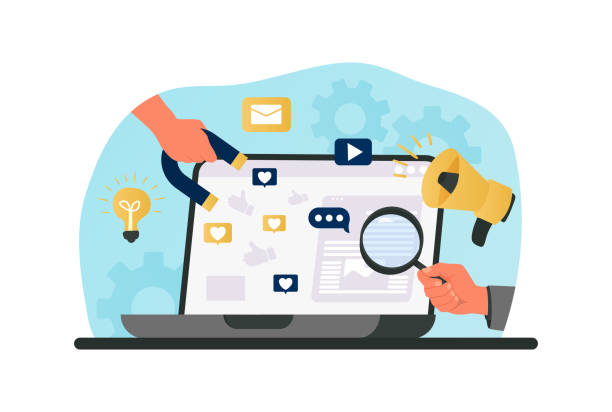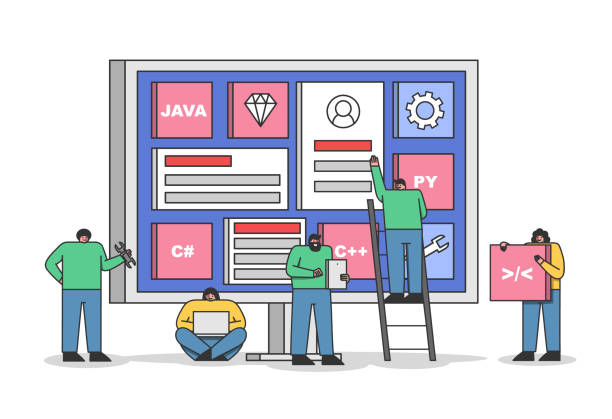Why is Secure Website Design Crucial?

In today’s digital world, where businesses increasingly rely on their online presence, the topic of #Secure_Website_Design has become more important than ever.
A secure website not only protects your business’s sensitive information but also gains #User_Trust.
Without sufficient security, your website can become an easy target for cyberattacks, leading to data loss, user privacy breaches, damage to brand reputation, and even heavy financial penalties.
Secure website design has transformed from an option into a necessity.
This not only includes protecting servers and secure coding but also involves continuous team training, regular system updates, and having an incident response plan.
The ultimate goal is to provide a stable and reliable online environment for your customers.
For example, an e-commerce website that fails to properly protect customer payment information will quickly lose its credibility.
Similarly, a blog or news site that is attacked and its content tampered with can lose its audience.
Therefore, from the earliest stages of development, cybersecurity must be at the core of the secure website design process.
This is an investment in the future of your business that can prevent much higher costs in the event of a security incident.
Ultimately, focusing on secure website design is not just a defensive measure but also a competitive advantage that helps you lead in the thriving digital market.
Do you have an online store, but your sales aren’t what you expect? Rasaweb solves your problem forever with professional e-commerce website design!
✅ Significant increase in conversion rates and sales
✅ Unparalleled user experience for your customers
⚡ Click to get free consultation with Rasaweb!
Understanding Common Website Threats

In today’s complex digital world, identifying and understanding #cyberattacks that target websites is the first step towards website security.
These threats are diverse and can make a website vulnerable through security gaps in code, servers, or even user behavior.
Among the most common and destructive of these attacks is #SQL_Injection, where attackers gain access to the website’s database by injecting malicious code into input forms, stealing or manipulating sensitive information.
Another serious threat is #XSS (Cross-Site Scripting) attacks, where malicious code is injected into web pages and executed in users’ browsers.
This can lead to the theft of cookies, user session information, and even modification of website content for users.
#DDoS (Distributed Denial of Service) attacks are also carried out by sending a huge volume of traffic to the server, aiming to disable the website and prevent legitimate users from accessing it.
These attacks not only lead to loss of revenue and business opportunities but can also severely damage brand reputation.
Furthermore, Brute-Force attacks, in which attackers systematically try all possible password combinations to gain access to accounts, remain a common threat.
Accurate understanding of these threats and their mechanisms helps development and security teams design and implement appropriate defenses in the secure website design process.
This proactive and awareness-raising approach is the cornerstone of an effective defensive strategy against a wide range of security risks that websites face daily.
Principles of Secure Coding and Development

Secure website design begins from the very first stages of coding.
Implementing #Secure_Development principles not only helps reduce vulnerabilities but also significantly lowers the costs associated with fixing security flaws in later stages.
One of the most important principles is #Input_Validation.
All data entering the system via forms, URLs, or any other external source must be carefully checked and sanitized to prevent the injection of malicious code such as SQL Injection or XSS.
Using Parameterized Queries when interacting with the database, instead of directly concatenating user inputs into queries, is an effective solution to combat SQL Injection.
Adhering to reputable security guidelines like #OWASP Top 10 is also essential for any team involved in secure website design.
OWASP provides a list of the top ten common web security vulnerabilities and suggests solutions for preventing them.
Furthermore, using web development frameworks that have built-in security mechanisms (such as preventing CSRF or XSS) can lighten the security burden on developers and facilitate the secure website design process.
In addition, proper error and exception handling is very important.
Displaying generic error messages to users and logging technical error details in secure logs, instead of showing sensitive information to attackers, prevents unnecessary information disclosure.
Regularly updating libraries and dependencies, applying the principle of Least Privilege for user and system access, and conducting security code reviews are all integral parts of a comprehensive secure website design process.
The table below provides a checklist of essential measures in this area:
| Security Measure | Description | Importance |
|---|---|---|
| Input Validation | Checking and sanitizing all user inputs to prevent code injection. | Very High |
| Using Parameterized Queries | Preventing SQL Injection attacks by separating data and code. | Very High |
| Proper Error Handling | Not displaying technical error details to users and logging them. | Medium |
| Updating Libraries | Using the latest secure versions of libraries and frameworks. | High |
| Precise Access Control | Granting the minimum necessary access to users and processes. | High |
Server and Infrastructure Security

Beyond coding, website security heavily depends on the stability and security of its hosting infrastructure.
#Server_security and proper infrastructure management form the backbone of any effort towards secure website design.
This includes multiple measures covering everything from hardware to server software and networking.
One of the first steps is secure server configuration; meaning all unnecessary services should be disabled, unnecessary ports closed, and default passwords must be changed.
Using powerful #firewalls, both hardware and software, is essential for controlling incoming and outgoing traffic to the server.
Firewalls can identify and block suspicious traffic patterns, prevent unauthorized access, and protect your website against common attacks such as port scanning and DDoS attacks.
Furthermore, regular updates of the server’s operating system and all installed software (such as web server, database, and programming languages) are highly important.
Many cyberattacks exploit known vulnerabilities in outdated software.
Installing #SSL/TLS_certificates is another crucial measure.
These certificates encrypt the connection between the user’s browser and the web server, preventing the eavesdropping of sensitive information such as login credentials or payment details.
This is not only essential for secure website design but also helps improve the website’s SEO ranking in search engines.
Using Intrusion Detection Systems (IDS) and Intrusion Prevention Systems (IPS) can also provide another defensive layer, helping to identify and prevent malicious activities in real-time.
The sum of these infrastructural measures lays the foundation for a secure and resilient website design against threats.
Are you concerned about your online store’s low conversion rate and not achieving your desired sales?
Rasaweb is your specialized solution for having a successful online store.
✅ Significant increase in conversion rates and sales
✅ Professional and user-friendly design to attract customer satisfaction
⚡ Ready for a transformation in online sales? Get a free consultation!
Data Protection and User Privacy

In the information age, data protection and ensuring #user_privacy are integral parts of website security.
With the increasing volume of personal data collected by websites, the responsibility to protect this information from unauthorized access and misuse also grows.
#Data_encryption is one of the most effective methods for protecting sensitive information, whether in transit or at rest.
Customer data, financial information, and other confidential data must be encrypted using strong encryption algorithms, such as AES-256.
Secure database design also plays a key role in this area.
This includes using user accounts with limited access for database connection, separately storing sensitive information (such as hashed and salted passwords), and applying the principle of least privilege.
This means that each user or service should only have access to the data they need for their functionality.
In addition to technical aspects, compliance with #privacy regulations such as GDPR in Europe, CCPA in California, and other national laws is vital for any secure website design that deals with user data.
These regulations establish strict frameworks for the collection, processing, and storage of personal data, and non-compliance can lead to heavy fines and loss of reputation.
User privacy breaches or #data_disclosure can have catastrophic consequences, including loss of customer trust, legal actions, and damage to brand reputation.
Therefore, at every stage of secure website design, from initial data collection to archiving, security and privacy measures must be prioritized.
This comprehensive approach ensures that users use your website’s services with greater confidence, knowing that their information is protected.
Robust Authentication and Access Management

One of the common entry points for cyberattacks is weak #authentication and access management systems.
To ensure secure website design, implementing strong authentication mechanisms and precise access control is crucial.
This involves compelling users to use #strong_and_unique_passwords that are a combination of uppercase and lowercase letters, numbers, and symbols.
Furthermore, storing passwords as hashed and salted values in the database, instead of in plain text, is essential to prevent user passwords from being exposed in case of a database breach.
#Multi-Factor_Authentication (MFA) or Two-Factor Authentication (2FA) adds an important layer of security.
With MFA, users need a second authentication factor (such as a code sent to a mobile phone, a fingerprint, or a hardware token) in addition to their password to log in.
This method significantly prevents unauthorized access, even if the password is stolen, and is highly effective for secure website design.
Session Management is also of high importance.
User sessions should expire after a defined period of inactivity, and session tokens must be securely generated and maintained to prevent session hijacking.
Sensitive information should never be placed in URLs or insecurely stored cookies.
#Access_control systems play a pivotal role in determining who can access what resources.
Implementing a Role-Based Access Control (RBAC) model allows organizations to set permissions based on user roles (e.g., administrator, editor, normal user).
This method not only reduces the complexity of managing permissions but also minimizes the likelihood of configuration errors leading to unauthorized access.
Together, these measures provide a robust authentication and access management framework, which is the cornerstone of a sustainable secure website design.
Security Audits and Penetration Testing

After secure website design and launch, the work of security doesn’t end; instead, it enters a critical phase of continuous monitoring and evaluation.
#Security_Audits and #Penetration_Testing are essential tools for identifying and remedying weaknesses before attackers discover and exploit them.
Security audits involve reviewing code, server configuration, and security processes to identify any breaches or non-compliance with security standards.
Penetration testing, often performed by security professionals (ethical hackers), simulates real attacks on a website.
The goal of these tests is to find #vulnerabilities in the system, network, or web applications.
These vulnerabilities can include software flaws, misconfigurations, or logical errors that can be exploited by attackers to gain unauthorized access to information or disrupt services.
The penetration test report includes details of discovered vulnerabilities, their severity, and recommendations for remediation.
Regularly conducting these tests and audits helps organizations gain a realistic view of their security posture and take necessary corrective actions.
This continuous process is crucial for maintaining #website_security in the face of evolving threats.
Some organizations even launch “Bug Bounty” programs where they reward security researchers for identifying and reporting vulnerabilities.
This dynamic and proactive approach to security, instead of reacting to attacks after they occur, allows for necessary measures for secure website design to be considered before incidents happen.
The table below shows some recommended tools and approaches in this area:
| Test/Tool Type | Description | Application in Security |
|---|---|---|
| Web Vulnerability Scanner | Automated tools for identifying common vulnerabilities (e.g., XSS, SQLi). | Initial weakness identification |
| Manual Penetration Testing | Deeper tests by experts to discover complex vulnerabilities. | Comprehensive and in-depth review |
| Static Application Security Testing (SAST) | Source code review to find vulnerability patterns without running the application. | Bug discovery in early development stages |
| Bug Bounty Program | Encouraging ethical hackers to find and report vulnerabilities in exchange for a reward. | Expanding testing scope and further discovery |
Incident Response and Disaster Recovery Plan

Even with the best #secure_website_design approaches and the implementation of the strongest security measures, the probability of a security incident is still not zero.
For this reason, having a comprehensive #Incident_Response_Plan and a #Disaster_Recovery_Plan strategy is essential for any business with an online presence.
An incident response plan outlines specific steps for identifying, containing, eradicating, recovering from, and learning from security incidents.
This plan should include roles and responsibilities for the incident response team, communication protocols (internal and external), and step-by-step processes for handling different types of incidents (such as intrusions, DDoS, or data breaches).
The main goal is to minimize damage, reduce downtime, and quickly restore website services.
Regular practice of these plans is vital to ensure team readiness and the effectiveness of the programs.
Complementing the incident response plan is the disaster recovery plan.
This plan focuses on recovering systems and data after a major disaster (such as widespread hardware failure, natural disasters, or cyberattacks leading to data loss).
A key part of this plan is a strategy for regular and reliable #website_data_and_configuration_backup.
These backups should be performed automatically, stored in secure and separate locations, and regularly tested to ensure their recoverability.
Having defined Recovery Points and Recovery Times helps businesses return to normal operations with minimal disruption in the event of a disaster.
Website security is a cyclical process that begins with prevention and is completed by the ability to recover quickly and effectively after an incident.
Without an effective response and recovery plan, even the most secure websites will be vulnerable to the catastrophic consequences of an attack.
Did you know that your company’s website is the first point of contact for 75% of potential customers?
Your website is the face of your brand. With **Rasaweb**’s corporate website design services, create an online presence that earns customer trust.
✅ Creating a professional and lasting image for your brand
✅ Attracting target customers and increasing online credibility
⚡ Get free consultation from **Rasaweb** experts!
The Human Factor: Weakest or Strongest Link in Security?

While there’s a strong focus on technology in #secure_website_design, it’s often overlooked that the #human_factor can be both the weakest and strongest link in the security chain.
#Social_engineering attacks, such as #Phishing and Spear Phishing, exploit human vulnerabilities and can bypass even the most sophisticated technical defenses.
In these attacks, attackers try to trick users into revealing sensitive information or performing actions that help the attacker gain access to systems.
The questionable content in this regard is why, despite widespread awareness campaigns, users still fall victim to these attacks? Is the problem a lack of #security_awareness or negligence? The answer is likely a combination of both.
Many individuals are unaware of the importance of their personal online security or cannot distinguish between a genuine email and a phishing email.
Regular training and awareness-building for employees and users are among the most important investments in #website_security.
These trainings should cover topics such as: recognizing phishing emails, the importance of using strong and unique passwords, enabling multi-factor authentication, and not clicking on suspicious links.
In addition to training, establishing a strong security culture within the organization is also vital.
This culture should encourage individual responsibility for security and enable employees to report security concerns without fear of reprisal.
When individuals are aware of the risks and know how to protect themselves, they can become a strong defensive wall instead of a weak point.
Therefore, in the secure website design process, one should not solely rely on technical aspects; investing in increasing the awareness and knowledge of the human factor can yield the greatest security returns and ultimately contribute significantly to secure website design in a broader sense.
Future Trends in Web Security

The world of web security is constantly evolving, and new threats emerge with technological advancements.
Therefore, to maintain #secure_website_design, understanding #future_trends_in_web_security and adapting strategies to them is essential.
One of the most important emerging trends is the increasing role of #Artificial_Intelligence and Machine Learning (AI/ML) in threat detection and prevention.
AI-based systems can identify complex attack patterns, detect anomalies in network traffic, and even automatically respond to threats, which significantly improves the #website_security process.
Blockchain also offers significant potential for enhancing data security and authentication.
Given the decentralized and immutable nature of blockchain, it can be used for secure storage of security logs, digital identity management, and ensuring data integrity.
This technology can significantly contribute to secure website design and the creation of high-trust systems.
The concept of “#Zero_Trust_Architecture” is also gaining popularity.
In this model, no user or device, whether inside or outside the network, is automatically trusted.
Every access request must be carefully authenticated and authorized, even if it originates from within the network.
This approach significantly enhances the level of security and prevents lateral movement attacks in case of an initial breach.
Furthermore, focusing on API (Application Programming Interface) security with the expansion of API-based services, and the increase in threats related to the Internet of Things (IoT) and supply chain attacks, are other areas that will gain more importance in the near future.
Keeping pace with these advancements and new threats is vital for any organization that values and maintains secure website design.
This means continuous learning, flexibility in implementing solutions, and looking to the future to protect digital assets against the evolving threat landscape.
Frequently Asked Questions
| Question | Answer |
|---|---|
| 1. What does secure website design mean? | Secure website design means creating a website that is resilient to cyberattacks and protects user and server data. |
| 2. Why is security important in website design? | To prevent data breaches, protect user privacy, maintain user trust, and avoid financial and reputational losses. |
| 3. What are the most common web vulnerabilities? | SQL Injection, Cross-Site Scripting (XSS), Cross-Site Request Forgery (CSRF), Broken Authentication, and Security Misconfiguration. |
| 4. How can SQL Injection be prevented? | By using Prepared Statements / Parameterized Queries, ORMs, and Input Validation. |
| 5. What is the role of HTTPS and SSL/TLS in site security? | HTTPS encrypts the communication between the user’s browser and the server using the SSL/TLS protocol, preventing data eavesdropping and tampering. |
| 6. What measures should be taken to prevent XSS attacks? | Input validation, output encoding to prevent malicious code execution, and using Content Security Policy (CSP). |
| 7. What does a strong password policy include? | Enforcing long passwords, a combination of uppercase and lowercase letters, numbers, and special characters, and preventing reuse. |
| 8. How does Two-Factor Authentication (2FA) help with security? | Even if a user’s password is compromised, the attacker cannot access the account without the second authentication factor (such as an SMS code or an app). |
| 9. What is a Web Application Firewall (WAF) and what is its use? | A WAF is a firewall that monitors and filters HTTP traffic between a web application and the internet to prevent common web attacks like SQL Injection and XSS. |
| 10. Why is regular updating of software and libraries important? | Updates often include security patches to address discovered vulnerabilities. Failure to update can expose the site to new attacks. |
And other advertising services of Rasaweb Advertising Agency
Smart Brand Identity: Designed for businesses seeking digital branding through the use of real data.
Smart Advertising Campaign: A combination of creativity and technology to attract customers through marketing automation.
Smart Direct Marketing: Transform digital branding with the help of SEO-driven content strategy.
Smart Customer Journey Map: A dedicated service for increasing website traffic based on marketing automation.
Smart Google Ads: Revolutionize website traffic growth with the help of Google Ads management.
And over hundreds of other services in the field of internet advertising, advertising consultation, and organizational solutions
Internet Advertising | Advertising Strategy | Advertorials
Resources
- Website Security Checklist
- 10 Tips to Increase Site Security
- Website Security Solutions
- Website Security: Why It Matters and How to Enhance It?
✅
? For a powerful presence in the digital world, Rasaweb Afarin accompanies your business by providing the best digital marketing services, including corporate website design.
📍 Tehran, Mirdamad Street, next to Bank Markazi, Kazeroon South Alley, Ramin Alley, No. 6




